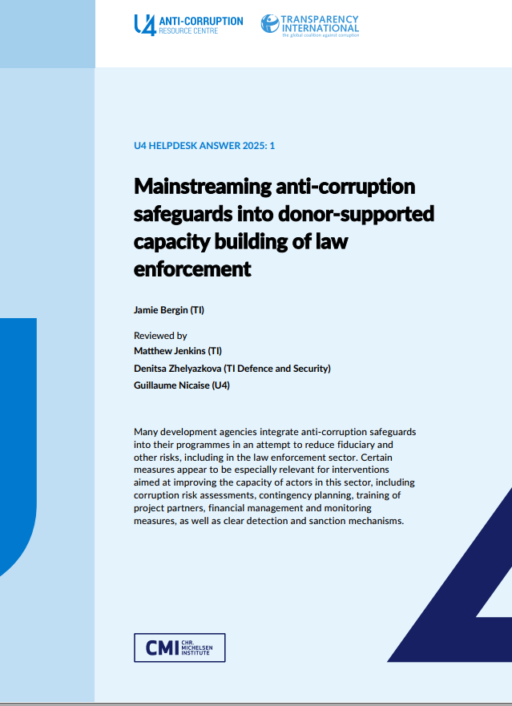- Home
- Anti-Corruption Helpdesk
- Mainstreaming anti-corruption safeguards into donor-supported capacity building of law enforcement
Mainstreaming anti-corruption safeguards into donor-supported capacity building of law enforcement

This Anti-Corruption Helpdesk brief was produced in response to a query from a U4 Partner Agency. The U4 Helpdesk is operated by Transparency International in collaboration with the U4 Anti-Corruption Resource Centre based at the Chr. Michelsen Institute.
Query
Please provide a summary of best practices on mainstreaming anti-corruption safeguards into donor-supported capacity building of law enforcement in partner countries.
Summary
Many development agencies integrate anti-corruption safeguards into their programmes in an attempt to reduce fiduciary and other risks, including in the law enforcement sector. Certain measures appear to be especially relevant for interventions aimed at improving the capacity of actors in this sector, including corruption risk assessments, contingency planning, training of project partners, financial management and monitoring measures, as well as clear detection and sanction mechanisms
Main points
- Capacity building programmes for law enforcement agencies (LEAs) are an important type of development intervention, but one that, as with all forms of donor-supported programming, carries fiduciary and reputational risks linked to corruption.
- These include the risk of conflicts of interest or bribery distorting the procurement of services related to training, favouritism in the nomination of participants, the abuse of per diem systems, and the embezzlement of funds and equipment.
- Such risks may be heightened in fragile states or those affected by conflict, or in settings where there is a prevailing environment of police corruption and impunity, as well as in complex programme models that involve multiple third parties.
- As part of a mainstreaming approach that seeks to reduce the risk of donor funds being misused, development agencies can integrate corruption risk assessments and corresponding mitigation measures into project documentation. This can help to set expectations and guide staff who are responsible for implementing capacity building interventions.
- Key mitigation measures could include ensuring such staff are adequately trained, that their financial management standards are high, that external monitoring and audits are facilitated and that clear processes exist to detect and sanction irregularities.
- Donors should additionally consider the potential need for making trade-offs with their greater development goals, adaptations of a standard approach depending on the local environment, and more integrated programming that addresses corruption beyond the immediate intervention.
Authors
Jamie Bergin (TI)
Reviewers
Matthew Jenkins (TI)
Denitsa Zhelyazkova (TI Defence and Security)
Guillaume Nicaise (U4)
Date
08/01/2025

